Python第6次作业
使用”数据4.3”数据文件(详情已在第4章习题部分中介绍),Profit contribution为利润贡献度,作为响应变量;Net interest income为净利息收入、Intermediate income为中间业务收入、Deposit and finance daily为日均存款加理财之和,均作为特征变量,构建决策树回归算法模型。
import numpy as np
import pandas as pd
from tqdm import tqdm
import matplotlib.pyplot as plt
from sklearn.model_selection import train_test_split
from sklearn.model_selection import KFold
from sklearn.model_selection import GridSearchCV
from sklearn.tree import plot_tree
from sklearn.tree import DecisionTreeRegressor, export_text
from sklearn.linear_model import LinearRegression
1. 变量设置及数据处理
data = pd.read_csv("../data/数据4.3.csv")
data.info()
<class 'pandas.core.frame.DataFrame'>
RangeIndex: 8441 entries, 0 to 8440
Data columns (total 5 columns):
# Column Non-Null Count Dtype
--- ------ -------------- -----
0 code 8441 non-null int64
1 Profit contribution 8441 non-null float64
2 Net interest income 8441 non-null float64
3 Intermediate income 8441 non-null float64
4 Deposit and finance daily 8441 non-null float64
dtypes: float64(4), int64(1)
memory usage: 329.9 KB
数据集包含8441条记录,5个字段,其中code为整数类型,其余4个为浮点数类型。所有字段均无缺失值。
data.isnull().values.any()
False
返回False表示数据集中不存在缺失值,数据完整性良好。
# 将样本示例全集分割为训练样本和测试样本
X = data.iloc[:, 1:] # 设置特征变量
y = data.iloc[:, 0] # 设置响应变量
X_train, X_test, y_train, y_test = train_test_split(
X, y, test_size=0.3, random_state=10
)
2. 未考虑成本-复杂度剪枝的决策树回归算法模型
model = DecisionTreeRegressor(max_depth=2, random_state=10)
model.fit(X_train, y_train)
print("拟合优度:", model.score(X_test, y_test))
拟合优度: 0.0357314987046895
未剪枝决策树模型在测试集上的R²值为0.0357,表明模型对数据的解释能力较弱。
plot_tree(model, feature_names=X.columns, node_ids=True, rounded=True, precision=3)
plt.savefig("out1.pdf") # 有效解决显示不清晰的问题

print("文本格式的决策树:", export_text(model, feature_names=list(X.columns)))
文本格式的决策树: |--- Deposit and finance daily <= 1.21
| |--- Intermediate income <= 8.68
| | |--- value: [4503.23]
| |--- Intermediate income > 8.68
| | |--- value: [6005.66]
|--- Deposit and finance daily > 1.21
| |--- Profit contribution <= 259.61
| | |--- value: [4343.20]
| |--- Profit contribution > 259.61
| | |--- value: [3966.01]
深度为2的决策树首先根据”日均存款加理财之和”进行分裂,然后在各子节点中根据其他特征进一步分裂,最终生成4个叶节点,每个叶节点对应一个预测值。
3. 构建考虑成本-复杂度剪枝的决策树回归算法模型
model = DecisionTreeRegressor(random_state=10)
path = model.cost_complexity_pruning_path(X_train, y_train)
print("模型复杂度参数:", max(path.ccp_alphas)) # 输出最大的模型复杂度参数
print("模型总均方误差:", max(path.impurities)) # 输出最大的模型总均方误差
模型复杂度参数: 145056.0931541454
模型总均方误差: 5902836.331344441
最大的ccp_alpha值为145056.09,此时对应最大的模型总均方误差为5902836.33。这些值将用于后续剪枝过程中的参数选择。
4. 绘制图形观察”叶节点总均方误差随alpha值变化情况”
fig, ax = plt.subplots()
ax.plot(path.ccp_alphas, path.impurities, marker="o", drawstyle="steps-post")
ax.set_xlabel("有效的alpha(成本-复杂度剪枝参数值)")
ax.set_ylabel("叶节点总均方误差")
ax.set_title("叶节点总均方误差alpha值变化情况")
Text(0.5, 1.0, '叶节点总均方误差alpha值变化情况')
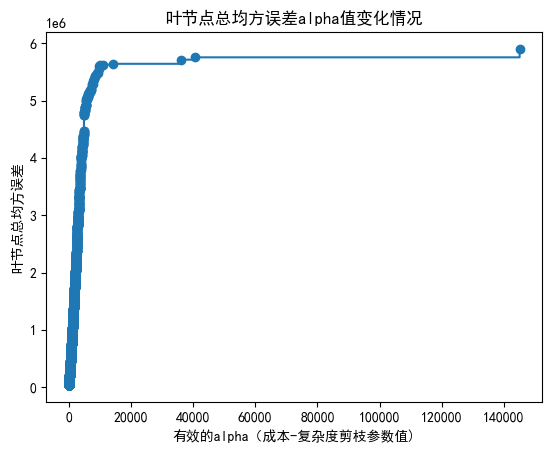
5. 绘制图形观察”节点数和树的深度随alpha值变化情况”
models = []
for ccp_alpha in tqdm(path.ccp_alphas):
model = DecisionTreeRegressor(random_state=10, ccp_alpha=ccp_alpha)
model.fit(X_train, y_train)
models.append(model)
print(
"最后一棵决策时的节点数为: {} ;其alpha值为: {}".format(
models[-1].tree_.node_count, path.ccp_alphas[-1]
)
) # 输出最path.ccp_alphas中最后一个值,即修剪整棵树的alpha值,只有一个节点
100%|██████████| 4643/4643 [11:00<00:00, 7.03it/s]
最后一棵决策时的节点数为: 1 ;其alpha值为: 145056.0931541454
成功训练了4643个不同alpha值的决策树模型,耗时约11分钟。当alpha取最大值145056.09时,决策树被剪枝为只有1个节点,即完全剪枝的状态。
node_counts = [model.tree_.node_count for model in models]
depth = [model.tree_.max_depth for model in models]
fig, ax = plt.subplots(2, 1)
ax[0].plot(path.ccp_alphas, node_counts, marker="o", drawstyle="steps-post")
ax[0].set_xlabel("alpha")
ax[0].set_ylabel("节点数nodes")
ax[0].set_title("节点数nodes随alpha值变化情况")
ax[1].plot(path.ccp_alphas, depth, marker="o", drawstyle="steps-post")
ax[1].set_xlabel("alpha")
ax[1].set_ylabel("决策树的深度depth")
ax[1].set_title("决策树的深度随alpha值变化情况")
fig.tight_layout()
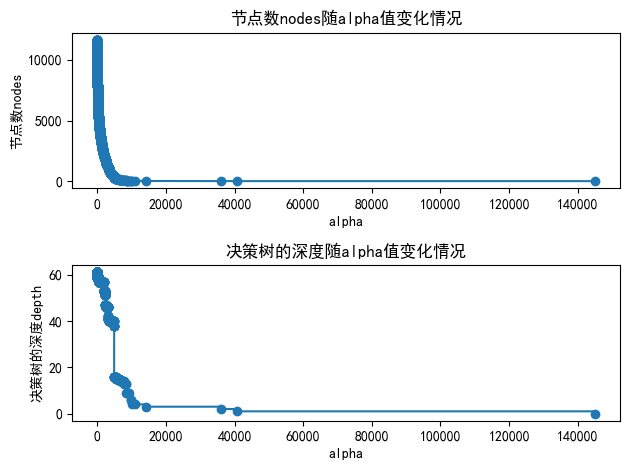
6. 绘制图形观察”训练样本和测试样本的拟合优度随alpha值变化情况”
train_scores = [model.score(X_train, y_train) for model in models]
test_scores = [model.score(X_test, y_test) for model in models]
fig, ax = plt.subplots()
ax.set_xlabel("alpha")
ax.set_ylabel("拟合优度")
ax.set_title("训练样本和测试样本的拟合优度随alpha值变化情况")
ax.plot(
path.ccp_alphas, train_scores, marker="o", label="训练样本", drawstyle="steps-post"
)
ax.plot(
path.ccp_alphas, test_scores, marker="o", label="测试样本", drawstyle="steps-post"
)
ax.legend()
plt.show()
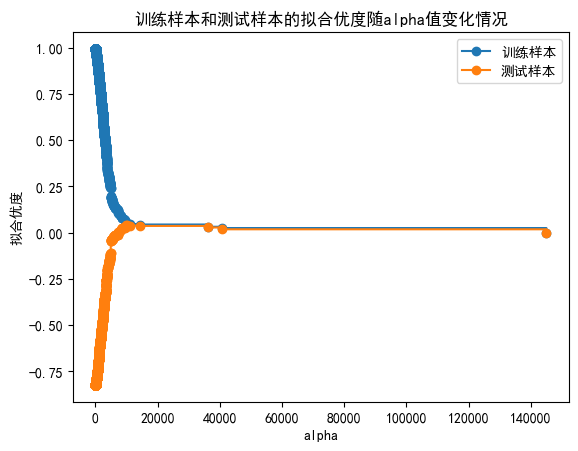
7. 通过10折交叉验证法寻求最优alpha值并开展特征变量重要性水平分析
7.1 通过10折交叉验证法寻求最优alpha值
param_grid = {"ccp_alpha": path.ccp_alphas}
kfold = KFold(n_splits=10, shuffle=True, random_state=10)
model = GridSearchCV(DecisionTreeRegressor(random_state=10),
param_grid,
cv=kfold,
n_jobs=-1) # 使用所有可用CPU核心
model.fit(X_train, y_train)
print("最优alpha值:", model.best_params_)
最优alpha值: {'ccp_alpha': 14222.786552228266}
通过10折交叉验证找到的最优alpha值为14222.79,该值将用于构建最终的决策树模型。
model = model.best_estimator_
print("最优拟合优度:", model.score(X_test, y_test))
print("决策树深度:", model.get_depth())
print("叶节点数目:", model.get_n_leaves())
print("每个变量的重要性:", model.feature_importances_)
最优拟合优度: 0.03600534073366668
决策树深度: 3
叶节点数目: 5
每个变量的重要性: [0.27985142 0. 0.15794261 0.56220597]
最优模型性能分析:
- 拟合优度R²值为0.0360,略高于未剪枝模型
- 决策树深度为3,包含5个叶节点
- 特征重要性显示:”日均存款加理财之和”(0.562)最重要,其次是”Profit contribution”(0.280)和”Intermediate income”(0.158),而”Net interest income”的重要性为0。
7.2 决策树特征变量重要性水平分析
sorted_index = model.feature_importances_.argsort()
plt.barh(range(X_train.shape[1]), model.feature_importances_[sorted_index])
plt.yticks(np.arange(X_train.shape[1]), X_train.columns[sorted_index])
plt.xlabel("特征变量重要性水平")
plt.ylabel("特征变量")
plt.title("决策树特征变量重要性水平分析")
plt.tight_layout()
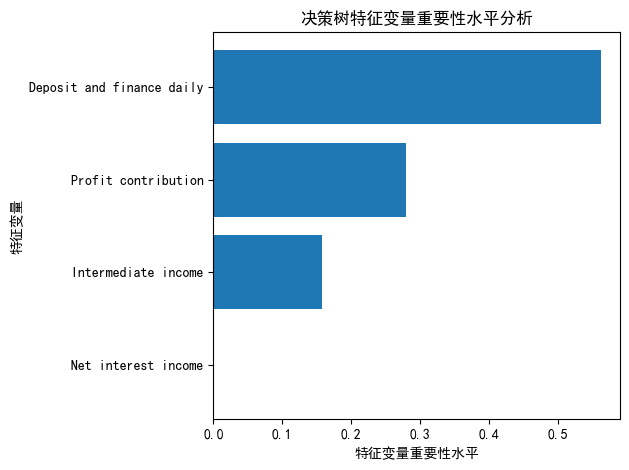
plot_tree(
model,
feature_names=X.columns,
node_ids=True,
impurity=True,
proportion=True,
rounded=True,
precision=3,
)
plt.savefig("out2.pdf")

8. 最优模型拟合效果图形展示
pred = model.predict(X_test) # 对响应变量进行预测
t = np.arange(len(y_test)) # 求得响应变量在测试样本中的个数,以便绘制图形。
plt.plot(t, y_test, "r-", linewidth=2, label="原值") # 绘制响应变量原值曲线。
plt.plot(t, pred, "g-", linewidth=2, label="预测值") # 绘制响应变量预测曲线。
plt.legend(loc="upper right") # 将图例放在图的右上方。
plt.grid()
plt.show()
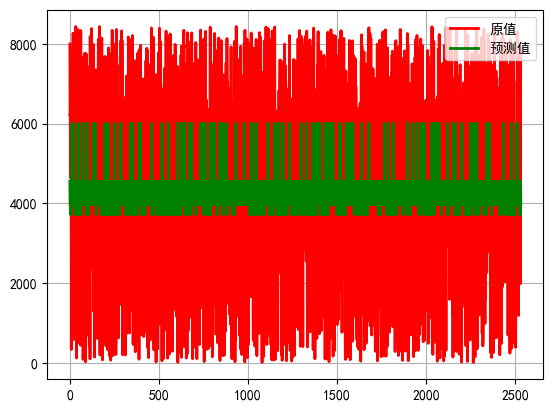
9. 构建线性回归算法模型进行对比
model = LinearRegression().fit(X_train, y_train)
model.score(X_test, y_test)
4.4562697989802835e-05
线性回归模型的R²值为4.46×10⁻⁵,远低于决策树模型,表明在这个问题上,决策树回归算法表现优于线性回归算法。